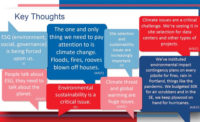Two major challenges facing the construction industry of tomorrow—its future workforce and the looming disaster of climate change—headlined the first in-person, joint conference of the Construction Industry Institute and the Construction Users Roundtable, held Aug. 2-4 in Orlando,
Members of the research team focused on Workforce 2030 noted that ongoing industry trends and predictions about the way construction work gets done—and who does it—have not always proven out.
Despite industry’s efforts, the construction workforce is growing older, with the industry's average age rising from 36.8 in 1994, to 42.9 in 2020. By 2030, it is estimated average age will rise to roughly 46.
And while “our industry has talked about construction robots coming to save us for 40 or 50 years,” Timothy Taylor, professor of engineering and project management at the University of Kentucky, said, “they're largely not here yet, and they're not going to be here in 2030, at least how we typically think about them.”
Instead, by 2030, Taylor argued, human-assisted robotics could be providing the aging construction workforce with a productivity boost. “Perhaps that’s a way that we see improvement,” he said.
There’s clear room for improvement. For instance, the research team’s presentation noted that supervisors spend less than 40% of their time supervising. To address that particular shortcoming, Taylor said, contractors should seek out technology that helps supervisors to “be at the work face, getting the work done and not sitting in a jobsite trailer trying to get the latest piece of technology that's not working to work.”
Multiskilling, where a craftworker is certified in more than one trade, is another trend that hasn’t played out exactly as planned, says Dr. Paul Goodrum, department head of Colorado State University’s construction management department. Promoted, he says, since the late 1990s as a labor strategy for a smaller workforce, “the actuality is a little bit different” in ways that could cause other future challenges.
For instance, the increase in the percentage of craft workers’ spouses who are employed—which is up from roughly 50% in 1980 to more than 80% in 2010—is driving the unintended consequence of decreasing worker mobility.
Essentially, says Daniel Groves, director of strategic initiatives with CURT, “If you're a craft worker in a dual-income household, you are considerably less likely and less flexible in terms of either moving or traveling.”
As a result, Groves says, “Multiskilling is beginning to replace mobility.” He adds that mobility “is pretty critical in our industry,” especially in areas like the Gulf Coast where there’s a significant reliance on craft workers.
The industry should therefore consider employing even more prefabrication, he asserts. “I think there's a real opportunity here for our industry if we were to seize it,” Groves said.
Is Climate Change Looming?
Is it too late to forestall the effects of climate change? That was the first audience question to a conference Q&A session with a panel addressing the topic of renewable fuels, carbon capture and carbon management.
To address the challenge, negative emissions technologies will have to play a role.
“There’s no net zero without carbon capture,” says Nigel Jenvey, managing partner with oil field services company Baker Hughes. “It’s fundamentally important to achieve net zero through negative emissions technologies such as bioenergy.”
Kelcey Henderson, president of Continuum Advisory Group, offered a comparison. She said, “I think that we’re all thinking about this as though we are on a burning platform. Really though, we’re acting as though the platform’s just kind of smoldering. And I think that's where the hang-up on cost happens.”
Henderson gave the example of California utility PG&E’s recent announcement that it would spend $30 billion on underground power lines. “Eventually, the platform really did catch fire, and they found the money that they thought was impossible to find.”
In an earlier presentation highlighting his company’s global efforts to address climate change, Jim Ellis, Microsoft’s corporate vice president for global construction, implored CII-CURT attendees to join the fight.
“Frankly, we’re polluting the heck out of this Earth,” he told those in attendance. “I believe one of the key solutions is, how do we work together, collaboratively at the intersection of technology and science to make a difference?”




